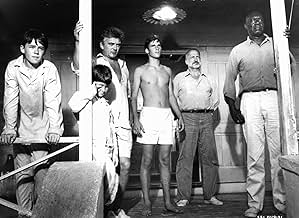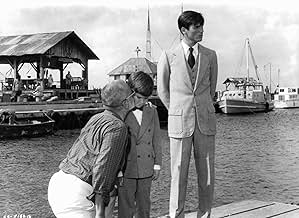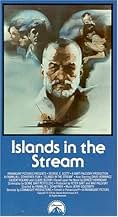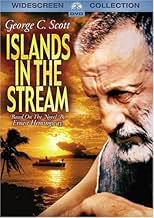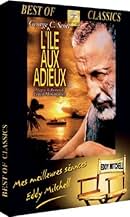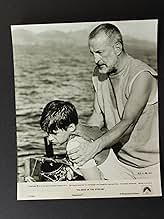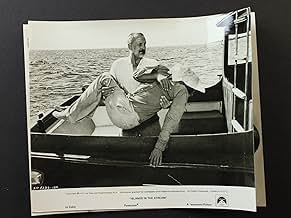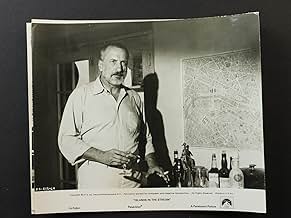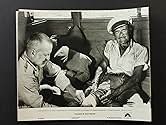IMDb RATING
6.5/10
1.7K
YOUR RATING
An isolated sculptor is visited by his three sons just before the start of WWII.An isolated sculptor is visited by his three sons just before the start of WWII.An isolated sculptor is visited by his three sons just before the start of WWII.
- Director
- Writers
- Stars
- Nominated for 1 Oscar
- 4 nominations total
- Director
- Writers
- All cast & crew
- Production, box office & more at IMDbPro
Featured reviews
Islands in the Stream (1977); Directed by: Franklin J. Schaffner; Starring: George C. Scott, David Hemmings, Hart Bochner, Clair Bloom et al.
This film didn't attract too much attention to itself, even though it marks the reunion of Franklin J. Schaffner and George C. Scott, who first collaborated on the magnificent "Patton", and it's an adaptation of a Hemmingway novel. It's almost forgotten by now, but luckily Paramount released a DVD of it, so that today's audience can discover this wonderful 'forgotten' film. I bought this film for the pairing of Schaffner and Scott and the score by Jerry Goldsmith. To say the least: I wasn't disappointed.
This is a contemplative film, with many low-key scenes and a slow pace. It's about Thomas Hudson, who has retreated to an island in the Bahamas and is working there quietly as an artist. His best friend Eddy is there too and he's looked after by Hudson, because he is a rummy and gets in a fight a bit too often. Joseph helps Hudson out in his daily business and the two are close friends. The film is made up of three chapters. The first chapter is called "The Boys" and is about Hudson's three sons visiting him for the summer. His eldest son, Tommy, is from his first marriage and the younger two, David and Andrew, are from his second marriage. While the oldest and the youngest sons can get along with Hudson really well, it's David who holds a grudge against him for leaving him and his mother. Only after a fishing trip, where he struggles with a marlin for over three hours, does he forgive his father and does he embrace him. During their stay on the island, the Second World War draws closer and they can see burning ships on the horizon. After the boys have left, they receive a letter from their father, stating that he misses them very much and that their time together made him happy again. This chapter serves to pinpoint that although Hudson loves his retreat on the island, he also misses his boys really much and that they might be more important than himself. The second chapter is called "The Woman" and is about Hudson's first wife, Audrey, visiting the island. They talk a lot about their love for each other and the reasons for their failure together. When they're at Hudson's house and she starts drinking more and more he realizes that she's here to bring him very bad news. "The Journey" is the final chapter and tells the story of how Hudson finally realizes that he has to be with his boys on the mainland, instead of remaining forever on his island. In a way he decides to finally live again. He goes on a journey to the mainland, but the war gets between him and his goal. On the ocean he has to take a group of Jewish refugees onboard, because their ship was raided by the Cuban coastguard and they barely escaped. He decides that he should take them to shore, but when he does so, he has to escape the coastguard himself. The journey ends on a river somewhere nearby the Cuban coast, where Hudson pays a high price for his decision to start living again.
The film is beautifully filmed by Franklin Schaffner and the cinematography by Fred Koenekamp is gorgeous. Continuing their great working relation, Franklin hired Jerry Goldsmith to score the film. He delivers one of his most touching and most beautiful scores. It fits the film perfectly, capturing the emotional state Hudson is in with an almost melancholy theme, which is as restrained as Hudson and the film itself. There's a more whimsical theme for the boys and there is a majestic cue over the marlin fishing scene. Goldsmith also captures the rhythm of the ocean with his music. He's able to perfectly merge the emotions on screen with his music and he adapts his themes beautifully and in keeping with the heart of the film. The score thus becomes the film's heart and perhaps the best part about it. This is one of the best scores ever composed for a motion picture.
The performances are magnificent too. George C. Scott delivers a very subtle and beautifully executed performance, capturing the essence of Hudson's feelings and making his struggle feel entirely realistic. His performance is restrained, yet it gives a great view into the heart of the troubled main character. David Hemmings also delivers a great performance, making the audience feel sorry for Eddy, but also love him, He also makes Eddy's and Hudson's friendship a joy to watch. Clair Bloom as the first wife and Julius Harris as Joseph are great too, as are the actors playing the boys. Especially Michael-James Wixted as David is great, but Hart Bochner (as Tommy) and Brad Savage (as Andrew) deliver good performances too.
The film is very restrained and quiet and feels very real. The audience gets time to relate to Hudson as the film slowly tells more about him. The emotions are therefore never forced, nor do they feel faked. They feel real and the emotional journey becomes entirely believable and understandable. This approach is sadly quite seldom in Hollywood films. There's one problem though: the final chapter feels a bit off in relation to the other two chapters. The film moves into a chase and Hudson suddenly sympathizes a lot with the refugees, where he was much more restrained at first. Therefore the final chapter is not completely in line with Hudson's character. In the book he chases a German U-boat crew, instead of getting sympathetic with Jewish refugees, which sounds more right for the character. The last scenes are really powerful though, as is the final impact of this film. It made me quiet afterwards, contemplating the journey I had just taken with Hudson, but it also left a warm feeling behind.
8/10.
This film didn't attract too much attention to itself, even though it marks the reunion of Franklin J. Schaffner and George C. Scott, who first collaborated on the magnificent "Patton", and it's an adaptation of a Hemmingway novel. It's almost forgotten by now, but luckily Paramount released a DVD of it, so that today's audience can discover this wonderful 'forgotten' film. I bought this film for the pairing of Schaffner and Scott and the score by Jerry Goldsmith. To say the least: I wasn't disappointed.
This is a contemplative film, with many low-key scenes and a slow pace. It's about Thomas Hudson, who has retreated to an island in the Bahamas and is working there quietly as an artist. His best friend Eddy is there too and he's looked after by Hudson, because he is a rummy and gets in a fight a bit too often. Joseph helps Hudson out in his daily business and the two are close friends. The film is made up of three chapters. The first chapter is called "The Boys" and is about Hudson's three sons visiting him for the summer. His eldest son, Tommy, is from his first marriage and the younger two, David and Andrew, are from his second marriage. While the oldest and the youngest sons can get along with Hudson really well, it's David who holds a grudge against him for leaving him and his mother. Only after a fishing trip, where he struggles with a marlin for over three hours, does he forgive his father and does he embrace him. During their stay on the island, the Second World War draws closer and they can see burning ships on the horizon. After the boys have left, they receive a letter from their father, stating that he misses them very much and that their time together made him happy again. This chapter serves to pinpoint that although Hudson loves his retreat on the island, he also misses his boys really much and that they might be more important than himself. The second chapter is called "The Woman" and is about Hudson's first wife, Audrey, visiting the island. They talk a lot about their love for each other and the reasons for their failure together. When they're at Hudson's house and she starts drinking more and more he realizes that she's here to bring him very bad news. "The Journey" is the final chapter and tells the story of how Hudson finally realizes that he has to be with his boys on the mainland, instead of remaining forever on his island. In a way he decides to finally live again. He goes on a journey to the mainland, but the war gets between him and his goal. On the ocean he has to take a group of Jewish refugees onboard, because their ship was raided by the Cuban coastguard and they barely escaped. He decides that he should take them to shore, but when he does so, he has to escape the coastguard himself. The journey ends on a river somewhere nearby the Cuban coast, where Hudson pays a high price for his decision to start living again.
The film is beautifully filmed by Franklin Schaffner and the cinematography by Fred Koenekamp is gorgeous. Continuing their great working relation, Franklin hired Jerry Goldsmith to score the film. He delivers one of his most touching and most beautiful scores. It fits the film perfectly, capturing the emotional state Hudson is in with an almost melancholy theme, which is as restrained as Hudson and the film itself. There's a more whimsical theme for the boys and there is a majestic cue over the marlin fishing scene. Goldsmith also captures the rhythm of the ocean with his music. He's able to perfectly merge the emotions on screen with his music and he adapts his themes beautifully and in keeping with the heart of the film. The score thus becomes the film's heart and perhaps the best part about it. This is one of the best scores ever composed for a motion picture.
The performances are magnificent too. George C. Scott delivers a very subtle and beautifully executed performance, capturing the essence of Hudson's feelings and making his struggle feel entirely realistic. His performance is restrained, yet it gives a great view into the heart of the troubled main character. David Hemmings also delivers a great performance, making the audience feel sorry for Eddy, but also love him, He also makes Eddy's and Hudson's friendship a joy to watch. Clair Bloom as the first wife and Julius Harris as Joseph are great too, as are the actors playing the boys. Especially Michael-James Wixted as David is great, but Hart Bochner (as Tommy) and Brad Savage (as Andrew) deliver good performances too.
The film is very restrained and quiet and feels very real. The audience gets time to relate to Hudson as the film slowly tells more about him. The emotions are therefore never forced, nor do they feel faked. They feel real and the emotional journey becomes entirely believable and understandable. This approach is sadly quite seldom in Hollywood films. There's one problem though: the final chapter feels a bit off in relation to the other two chapters. The film moves into a chase and Hudson suddenly sympathizes a lot with the refugees, where he was much more restrained at first. Therefore the final chapter is not completely in line with Hudson's character. In the book he chases a German U-boat crew, instead of getting sympathetic with Jewish refugees, which sounds more right for the character. The last scenes are really powerful though, as is the final impact of this film. It made me quiet afterwards, contemplating the journey I had just taken with Hudson, but it also left a warm feeling behind.
8/10.
George C. Scott is at his best in this adaptation of a Hemingway story (which, if I'm not mistaken was left unfinished) about a man who, late in life, is experiencing regrets over the loss of time with his sons. The main character, like Hemingway, was married multiple times and always seemed to run out on them shortly after the children were born. As a result, his relationships with his three sons is strained, to say the least. It's obvious Hemingway was being autobiographical here, but unlike the lead in the movie who tries to make good (albiet late), Hemingway chose suicide over mending fences. At least the lead character TRIES to make a run from his tropical island home to the mainland to be with his kids full-time. To me, these parallel stories (true and fictional) makes this movie incredibly sad and wistful, while at the same time great acting and exceptional writing provide great impact as well.
With Islands In The Stream, George C. Scott took his place as an existential Hemingway hero along side such Hollywood luminaries as Gary Cooper, Humphrey Bogart, Gregory Peck, Spencer Tracy, Tyrone Power and Rock Hudson. With that beard he grew for the film he even looks the part of Hemingway.
In this partially autobiographical novel it's first set in the Bahamas where Scott, a painter has gone to get away from the rest of the world. He fishes, he consorts with loose women, and when he's got time and a need for cash, he paints and sells the product to keep going. It sounds like an ideal existence.
Unfortunately World War II intervenes and his three sons by different women all visit him. The oldest, Hart Bochner, has made his mind up to enlist in the Royal Air Force. The two youngest go back to Europe.
One of Scott's good friend is charter boat captain Gilbert Roland who has a side living smuggling refugees, mostly Jews, from Europe to any place in the western hemisphere he can drop them off. A lot times that's Cuba, but the Cuban government is taking a dim view of his activities.
Scott also has as two good friends, native Bahamian Julius Harris, and David Hemmings a young man with a drinking problem. Hemmings's character is ripped off from Hemingway's previous story, To Have and Have Not although Walter Brennan was a good deal older. He even used the same name.
Claire Bloom is also around as the first wife who visits after their son leaves for service. Scott still loves her in his own way, but she's well aware of his fidelity problem. To remind them both is working girl Susan Tyrell.
Ernest Hemingway wrote the story in the early Fifties and discarded it and his widow published it in the early seventies. Probably Papa Hemingway didn't think all that much of it. It certainly doesn't rate with some of his better known work. But second rate Hemingway is better than first rate from most writers.
The cast all give uniformly good performances and the cinematography is just great. Reason enough to see it.
In this partially autobiographical novel it's first set in the Bahamas where Scott, a painter has gone to get away from the rest of the world. He fishes, he consorts with loose women, and when he's got time and a need for cash, he paints and sells the product to keep going. It sounds like an ideal existence.
Unfortunately World War II intervenes and his three sons by different women all visit him. The oldest, Hart Bochner, has made his mind up to enlist in the Royal Air Force. The two youngest go back to Europe.
One of Scott's good friend is charter boat captain Gilbert Roland who has a side living smuggling refugees, mostly Jews, from Europe to any place in the western hemisphere he can drop them off. A lot times that's Cuba, but the Cuban government is taking a dim view of his activities.
Scott also has as two good friends, native Bahamian Julius Harris, and David Hemmings a young man with a drinking problem. Hemmings's character is ripped off from Hemingway's previous story, To Have and Have Not although Walter Brennan was a good deal older. He even used the same name.
Claire Bloom is also around as the first wife who visits after their son leaves for service. Scott still loves her in his own way, but she's well aware of his fidelity problem. To remind them both is working girl Susan Tyrell.
Ernest Hemingway wrote the story in the early Fifties and discarded it and his widow published it in the early seventies. Probably Papa Hemingway didn't think all that much of it. It certainly doesn't rate with some of his better known work. But second rate Hemingway is better than first rate from most writers.
The cast all give uniformly good performances and the cinematography is just great. Reason enough to see it.
From the opening score and scenes of the water, I was drawn to watch this movie. It was filmed somewhere in the Caribbean and the location was breathtaking. George C. Scott was perfect in the role of Tom Hudson, an Ernest Hemingway-ish character who was a complicated, lonely artist and expatriate who sculpted, drank, and fished his life away. It wasn't until the tragic end that he came to know what he'd been missing.
The music score was haunting and beautiful. I was so impressed with it that I ordered the soundrack.
The music score was haunting and beautiful. I was so impressed with it that I ordered the soundrack.
Scott plays a sculptor living on an island visited by his three sons. This is is an adaptation of a story by Hemingway that works most of the time. The child actors are exceptional in their roles as is the rest of the cast. Probably one of Scotts premiere performances. The story takes many turns, with the finest moments in the first half of the movie. I recommend viewing Islands in the Stream.
Did you know
- TriviaJerry Goldsmith often said this was his favorite score he composed.
- GoofsWhen the boat is slowly cruising up the river in Cuba looking for refugees, a crew member's hand can be seen moving tree branches away from the camera.
- Quotes
Thomas Hudson: I know now there's no "one thing" that is true. It is all true.
- ConnectionsFeatured in Survival Scars: Franklin J. Schaffner as Auteur (2023)
- How long is Islands in the Stream?Powered by Alexa
Details
Box office
- Gross US & Canada
- $5,596,173
- Gross worldwide
- $5,596,173
Contribute to this page
Suggest an edit or add missing content


